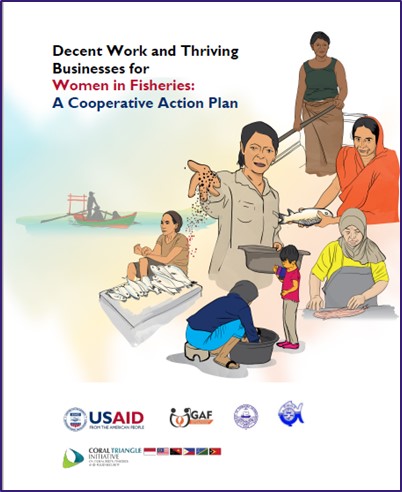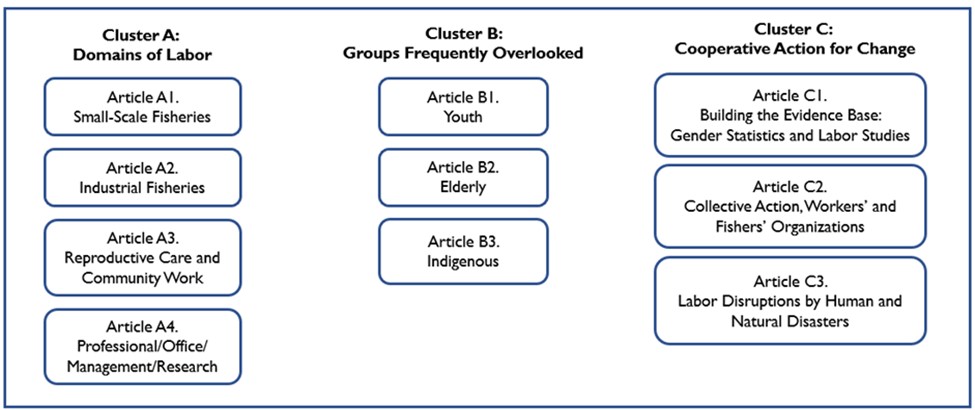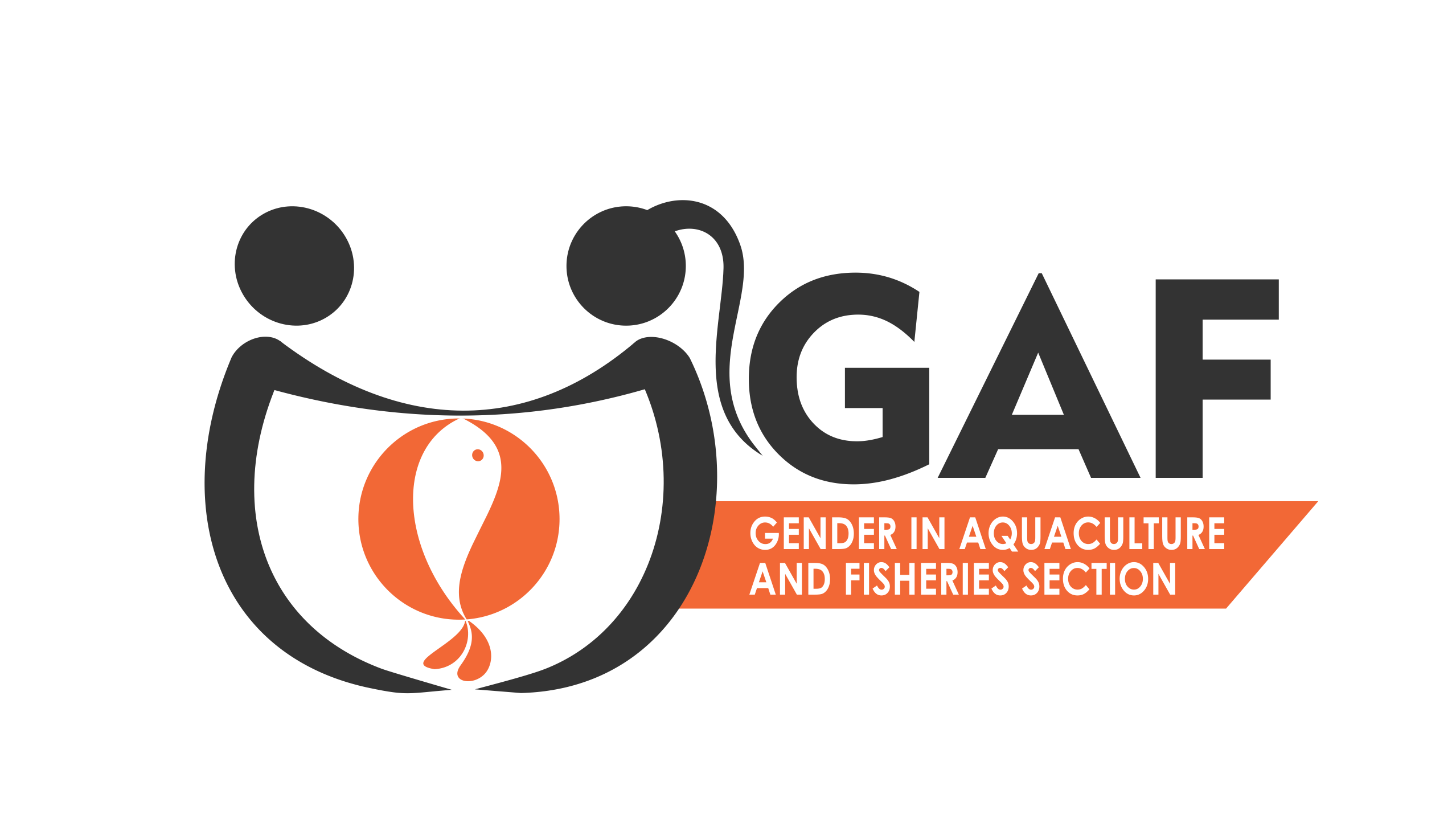The Gender in Aquaculture and Fisheries Section of the Asian Fisheries Society collaborated with the USAID Sustainable Fish Asia Local Capacity Development Activity to develop an action plan to recognize the women working in fisheries and to ensure decent work and an enabling environment for women’s businesses to thrive. The document titled, Decent Work and Thriving Businesses for Women in Fisheries: A Cooperative Action Plan, was launched on June 24, 2022 and can be found here: Link
The goal of the Plan is to contribute to greater regional understanding across stakeholder groups of key labor challenges for women in the fisheries sector and to support regional advancements for gender and just, equitable, and inclusive labor conditions across the Asia-Pacific fisheries sector.

Women’s work and issues in fisheries are usually considered as simply social or welfare but not work or business matters. This results in a lack of attention to women’s labor throughout all aspects of fisheries. This Cooperative Action Plan (the Plan) recognizes this issue and presents a guide for addressing gender and labor issues faced by women workers in Asia-Pacific fisheries and aquaculture. It focuses on women’s labor and business opportunities, recognizing that women are not a homogenous category and their needs vary according to their working situations, life stages from youth to elderly, ethnicity, education, social and economic positions, immigrant status, among others. The Plan identifies key issues or themes for action and provides articles giving guidance on actions for addressing these. The agencies that are recommended to take up the action, and possible partnerships and collaborations are indicated.
The objective of the Plan is to provide strategic direction, guidance, and recommendations to fisheries stakeholders and entities in the Asia-Pacific region in order to achieve the following in 5 years’ time:
- Key target audiences support the adoption of the Plan, in part or whole, and take action in accordance with its mandates;
- Women working in productive and reproductive roles in fisheries and aquaculture are given attention, voice, and strong representation in decision-making roles in policy, sector bodies, and businesses;
- Gender-based divisions of work in the household involve men and boys in domestic tasks, giving women and girls more opportunities to engage in strategic activities in the economy and community;
- The interests and contributions of young women and women in vulnerable groups such as migrants, Indigenous, handicapped, elderly, and other special groups are recognized and represented in policy and decision-making;
- Research and development are conducted to understand the situations and conditions of women and men working in fisheries and aquaculture, including long-term monitoring of gender-related interventions for impact assessments and systematic collection of sex/gender- disaggregated data, intersectional factors, and other relevant qualitative data; and
- Gendered impacts of current issues such as actions related to illegal, unreported, and unregulated (IUU) fishing, fisheries management and value chain changes, new business opportunities within and outside the fisheries sector, climate change, and the COVID-19 pandemic are taken into consideration and integrated in recovery programs, policies, and interventions.
The Plan is an output of the webinar, “Women Work in Fisheries, Too!” held last November 29, 2021, wherein activities that could help women flourish in Asian fisheries work were presented and discussed. The webinar was part of the 8th Global Symposium on Gender in Aquaculture and Fisheries (GAF8), and co-organized by the USAID SUFIA LCD; GAFS; Coral Triangle Initiative on Coral Reefs, Fisheries and Food Security (CTI-CFF); Indian Council of Agricultural Research -Central Institute of Fisheries Technology (ICAR-CIFT); and the Society of Fisheries Technologists (India) (SOFTI).
Initial drafts of the Plan were developed by a diverse team of gender fisheries experts, in advance of the webinar, who were invited for their expertise in fisheries and gender research in South and Southeast Asia and Pacific countries, socioeconomics, extension and human welfare, fisheries data systems, and fisheries policy analysis. An outline of the Plan was presented at the webinar, with preliminary feedback sought and incorporated before a draft was sent for open consultation and then finalized.
The Plan is intended for various audiences depending on the node(s) of the fisheries value chain in which they work. Many of the actions being recommended will require detailed design and practical application to be implemented effectively in different places and context.
The Plan covers 10 Articles grouped into three Clusters: Cluster A comprises the major domains of women’s fisheries labor; Cluster B addresses the needs of groups of women and girls who are frequently overlooked; and Cluster C comprises fundamental measures for building a solid platform for action. During the open consultation of the draft of the Plan, several suggestions were made to increase the numbers of groups addressed in Cluster B. Because several of the suggested groups, such as persons with disability, are lacking a knowledge base in fisheries to enable us to define actions, we chose to make reference to obtaining more information on these groups in articles under Cluster C.

Through this Plan, over the next five years, we hope to encourage a much deeper understanding of women’s labor in fisheries, while fostering decent work and thriving opportunities for women across the Asia-Pacific fisheries sector.
We welcome your inputs and feedback, and would appreciate learning about your activities and sharing news. A call to action to signify your or your organization’s interest and intent to work on the recommended actions can be found here: https://forms.office.com/r/nQZSkQb4vc.
*About the author
Dr Arlene Nietes Satapornvanit’s brief bio can be seen on the webpage of the Second Executive Committee of the Gender in Aquaculture and Fisheries Section of the Asian Fisheries Society GAF's Second-executive-committee
This entry was posted in: Asia, Fisheries, GAF8, Gender, Labour, Transgender, Value Chains, Women
